Li Fu Jie
Geoff and Sara have put up an excellent post about the little (it's 1km long, but very narrow!) street we live on - Li Fu Jie. Laetitia's also put up a Lifu Jie photo album.
A log of a year in Jiangsu Nanjing, from August 2006
Geoff and Sara have put up an excellent post about the little (it's 1km long, but very narrow!) street we live on - Li Fu Jie. Laetitia's also put up a Lifu Jie photo album.
It's said by some that the Chinese will eat anything. They'll certainly serve it up for idiot foreigners and boyishly proud men to devour! A market stall (at the same market where sugar dragons were found) was serving various deep fried insects. Having heard that starfish was not the nicest of dishes, I tried scorpions - one stick of little ones, and one stick with a big black one on.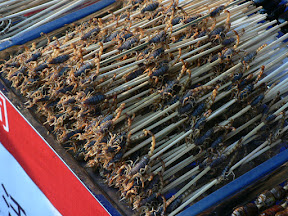
The stings look horrendous! I was quite worried that there would be some venom left in there, or that it would gouge your tongue while chewing on it. There's only one way to find out! The chefs courteously deep fried the shiny-carapaced creatures (which were of course already dead) and after waiting for them to cool, I carefully bit one of the small ones. It tasted slightly bitter, slightly burnt, and was very crunchy. There's nothing to it!
The big black one was slightly chewier, and the meat in the pincers isn't so hot. The best thing about this food is the looks you get from locals while grinning and commenting "Hao chi!"
- delicious!
On the way back from Fuzi Miao the other day, I stopped for a delicious and cheap meal of jaozi, which are essentially small meaty dumplings. It cost 1RMB, ar about 0.07 GBP. The guy cooked seven for me and served them. Boiling hot meaty goodness is fantastic after a hard afternoon's browsing at the market. For table service on hot food cooked to order, it doesn't get much better!
The bottles you can see, from left to right, are:
You can get sugar dragons made in front of your eyes here! While visiting the nearby lake, we found a small market, selling all kinds of unusual goods; skinned coconuts full of milk, deep fried scorpion, fresh Muslim lamb skewers from the far west, and sugar dragons!
A practiced Chinese gentleman will produce a board stuffed with little paintings with a spinning pointer at its centre, and ask a child to spin it. The pointer will land at an animal or object. The gentleman will then proceed to take a ladle of special syrup and whizz it over a smooth marble slab, flattening the sticky things he draws with a special metal tool when needed, where it quickly hardens into a detailed edible sugar dragon! Or a phoenix, or a bicycle, or anything! When the model's finished, he sticks it to a stick, and gives it to the child, who will parade it around for a while, and then quickly gobble it all up. It's fantastic!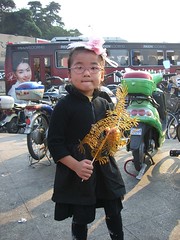
The Sea of Bamboo is a large natural forest of bamboo near the town of Yixing, Jiangsu. We visited it with a class from NUAA. It's a sight just like you'd expect from any cheesy brochures of China, or perhaps - more gratiatingly - high budget Chinese gong fu (kung fu) films; hordes of gently bowing white-ringed bamboo stalks, crowned with a handful of tiny spring green leaves, for as far and as deep as the eye can see. The Sea is tastefully accomodating to tourists, thanks to a plain wide path that leads through it, turning into stone steps or even a bamboo walkway at points.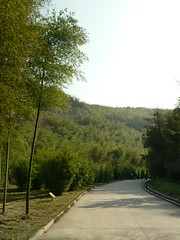
The path in
Green bamboo
The first great sight along this path is a very traditional pavilion at the top of a small grassy slope. Backed by photogenic rolling mountains which have just enough mist to highlight their creases, it's the perfect prelude to the next sight - Mirror Lake. This area is well tended to, and very clean and calm. On the other side of the lake is a series of small lakes and dotted trees, which can be seen while walking round the long way. If you go the short way, there's a traditional pagoda to relax in. If you're adventurous enough to climb the hills around the lake, there's a cute viewing platform hidden in the trees, offering a panorma of the area, and perfect for a quick kiss.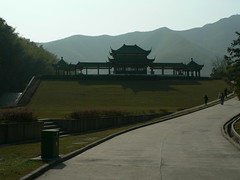
Pavilion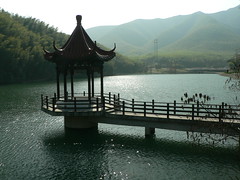
Mirror Lake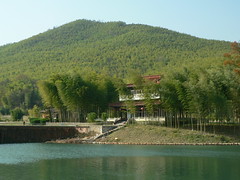
Pagoda shrouded in bamboo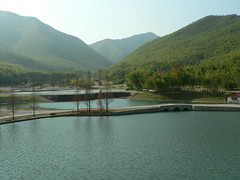
Higher parts of Mirror Lake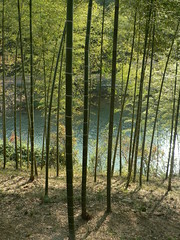
It's steep from the top!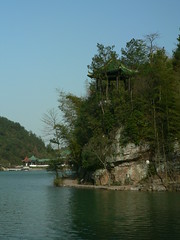
Viewing platform
Further along, the path climbs upwards into the mountain, all the time surrounded by bamboo plants. People love to carve their names or some words into the trees, or even just draw in the powdery dust which accumulates on the trunks. This continual flow of vary shades of green is occasionally punctuated by an ancient temple, cave entrance, or stream. And also a children's playing park, which was good fun! It's around 7km from the entrance to the summit, depending on which route you take. The air here is extremely good, especially compared to urban stuff, and it's a very serene place.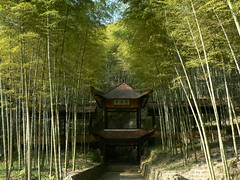
Cave entrance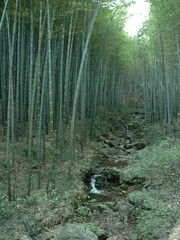
Mountain stream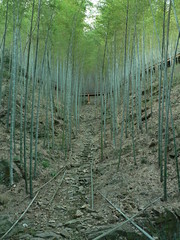
Rough path up to the bamboo walkway
After a little while, we came to a resting place that was the base of the climb to the summit. The trail turned to steps here, and there were workers dragging trunks of harvested bamboo down the paths (perhaps to be used as scaffolding, who knows!). It was hard work, though the climb was worthwhile. We took the bamboo walkway down, and then hopped onto an electric tour bus to get to the front gate, so as not to miss our ride home. The moon had risen just as we were leaving, giving a glorious glow to the mountain at the end of the day.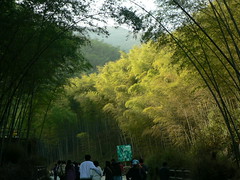
Bamboo fronds at sunset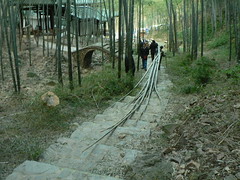
Carrying trunks down the steps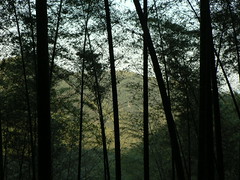
View from high up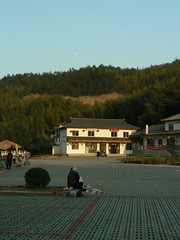
Thoroughly recommended!
Yixing, in northern Jiangsu province, is known throughout China for its dark clay. Many local businesses revolve around manufacturing earthenware goods from Yixing's "purple sand", either via mass production or by hand. Often, Chinese artists who work with clay will build their pieces out of material from this region. 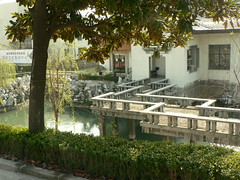
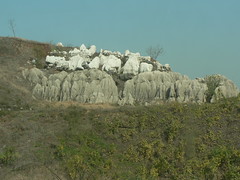
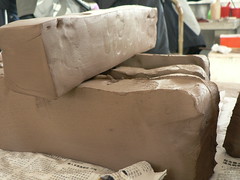
Yixing clay
We visited a teapot factory in Yixing, where people meticulously put together very high quality hand-made clay teapots.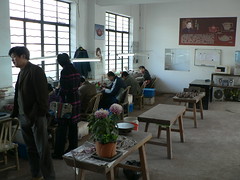
Each person will work on a different piece of the teapot - the spout, the handle, the base, the lid, and the main chamber. The work is very fine - despite making the walls of the teapot only 3 or 4 mm thick, the artisans manage to keep every part perfectly round and well formed. The end product looks as precise as a machine-built item could be, without manufacture marks.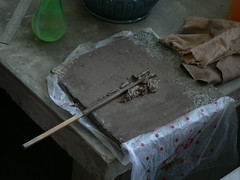
Wet clay, ready to be smoothed in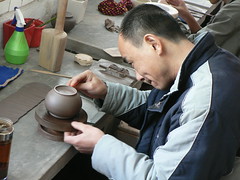
Smoothing the teapot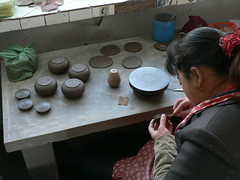
Finishing the lid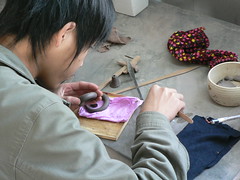
Making the handle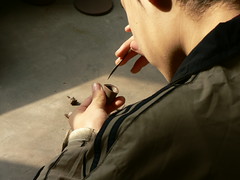
Carving a spout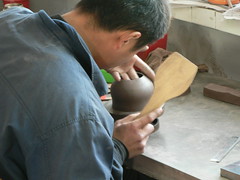
Thinning the chamber walls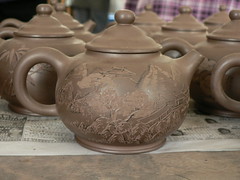
The finished product
On the ground floor of the factory is a small museum of teapots and tea sets made with Yixing clay by famous arists. Many are worth over 1 million RMB; for comparison, that's 100 000 Euro for a well-crafted and simple teapot.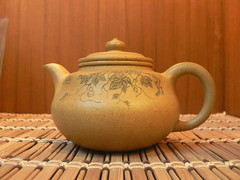
As well as a swelling pottery and glazing trade, there's a museum of pottery, containing a lot of ornate and interesting designs (mostly teapots!) in Yixing. There's some ancient pottery here, much older than most European countries, and also many beautiful exhibits of royal and modern earthware products.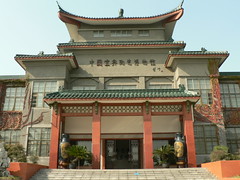
Yixing pottery museum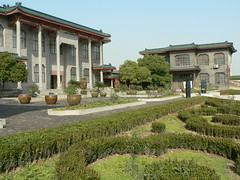
There's a fantastic huge bowl of heavy clay made for Emperors of the Ming Dynasty, whose is coloured a beautiful deep ivory tone and textured like large scales, topped by a green rim, over which lies a translucent sea green glaze. The full name is something along the lines of "Lotus Flower Dragon's Head Bowl". Unfortunately no photos were allowed here!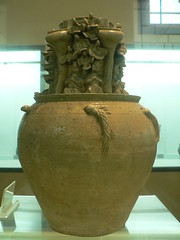
Around 200 years old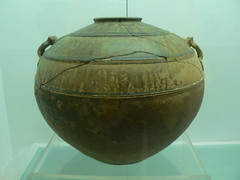
2000-3000 years old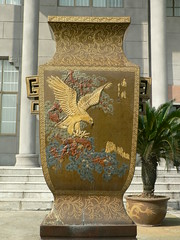
Relatively modern, and huge (~2m)
One very popular adornment to the teapots and the like we saw in Yixing is the inclusion of an old fighting beetle. I'm not sure of its English name. Men would place bets on their beetles, and whoever's beetle survived the fight would collect all the cash. There were also some very non-traditional looking pieces here, that could easily pass in any modern collection worldwide.
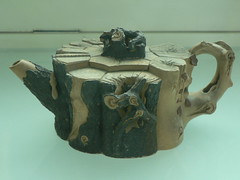
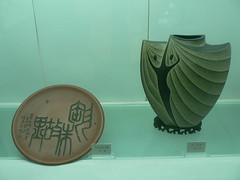
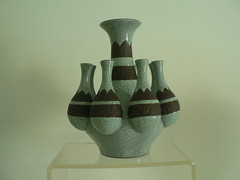
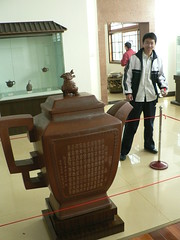
Yixing is also well known for its black rice. It's sticky, like most Chinese rice (imagine picking up grains of dry rice with chopsticks after a hard day's work!), and served with sugar. It's really delicious and goes well with most food. The tangy juices left by any even vaguely spicy dishes can be mopped up with sweetened black rice to make a very enjoyable mouthful! Around 4-7RMB for a 250g bag.
It's easy to collect pieces of purple clay Yixing pottery from any of the local dealers that crowd town; expect to pay about half the inital price offered. A 15cm long plain teapot goes for about 20-35RMB, with prices going up alongside size, as you'd expect!
If you're interested, you can pick up some genuine Yixing clay:
Antique Yixing teapots for sale
Cheap Yixing teapots
Fuzi Miao, the old Confucious temple, is now a shopping area and great tourist destination near the centre of Nanjing. Fuzi Miao has three official entrances, each of which is marked by a large heavily ornamented oriental-style wooden gate. It's quite a sprawling area and there are many other ways in, but these are the big ones.
| Fuzi Miao gate 1 |
| Fuzi Miao gate 2 |
| Fuzi Miao gate #3 |
| Underground electronics shop |
| Gate to the river in Fuzi Miao |
| Fuzi Miao boat rides |
| Fuzi Miao rickshaw drivers |
There seem to be some rather interesting sweets available - is this stuff really OK for kids?
 |
| From 20061022-dump |